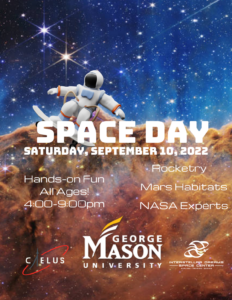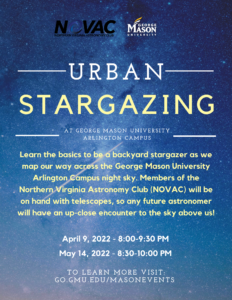
THIS EVENT IS CANCELED AND WILL BE RESCHEDULED FOR LATER THIS SUMMER.
RSVP here.
Members of the public are invited to view the urban night sky over George Mason University’s Arlington Campus through the telescopes of NOVAC volunteers.
Observing will take place on the outdoor plaza in front of Van Metre Hall (Schar School of Policy and Government). Visitor Parking is available in the Van Metre Hall Garage (hourly rate). There is also metered street parking around the campus.
As a reminder please ask permission from the telescope owner before using. Please monitor your children if they’re around expensive astronomical equipment.
Don’t forget to dress warmly. Please check the weather forecast.
Note: This outdoor event is weather-dependent and may be cancelled because of significant cloud cover or precipitation.
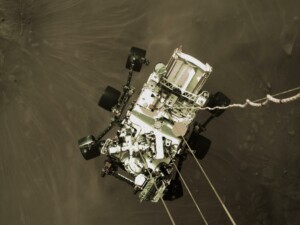
Mars 2020 Perseverance Rover: From Launch to Landing
Swati Mohan, Ph.D.
Sunday, May 15, 2022
7:30 PM to 9:00 PM EST
Online event
Monthly Meeting – Public Invited
Abstract:
The Mars 2020 mission was created to build off of the discoveries of its predecessors. The previous 4 rovers had found the building blocks for life on Mars. The Mars 2020 perseverance rover is the most advanced rover of the set, with each upgrade carefully designed to fit as much of the heritage Curiosity design as possible. Envisioned in 2012, launched in 2020, and landing on February 18, 2021 in the midst of a global pandemic, Perseverance made history as the 5th rover to land on Mars. Its express mission is to seek the signs of past life. Perseverance is the first leg of an ambitious program of Mars Sample Return. The samples collected by Perseverance could one day tell us whether there was past life on Mars. This talk will detail the scientific roadmap of the previous Mars rover missions, detail the evolution of landing technology, the augmentation of Perseverance to include Terrain Relative Navigation, and finally describe Perseverance’s journey from launch to landing.
Bio:
Dr. Swati Mohan joined NASA Jet Propulsion Laboratory first in 2004, after completing her B.S from Cornell University in Mechanical & Aerospace Engineering. After working as a systems engineer on Cassini during Saturn Orbit Insertion and Huygens Probe release, she returned to graduate school in 2005 to MIT. Dr. Mohan received her M.S. and Ph.D. in Aeronautics/Astronautics from the MIT Space Systems Laboratory. Since her return to JPL in 2010, Dr. Mohan has worked on multiple missions such as GRAIL and OCO-3. For the past 8 Years, she has been the Lead Guidance, Navigation and Controls Systems Engineer for Mars 2020 Perseverance rover, focusing on Cruise and EDL. In 2020, she transitioned to Mars 2020 Guidance, Navigation, and Controls Operations lead and mission commentator for the landing of the Perseverance rover on February 18, 202. She is currently the supervisor of the Guidance, Navigation, and Controls Systems Engineering group at NASA Jet Propulsion Laboratory and is working on the Mars Sample Retrieval Lander. Swati also co-founded and manages the Small Satellite Dynamics Test bed.
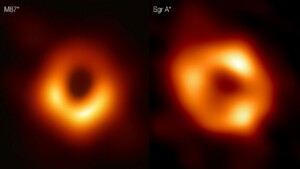
Public Monthly Meeting – Supermassive Black Holes at the Center of M87 and Milky Way: What We Learn
Razieh Emami, Ph.D.
Sunday, June 12, 2022
7:30 PM to 9:00 PM EST
Online event
Monthly Meeting – Public Invited
Abstract:
The most recent resolved images of Supermassive Black Holes (SMBHs) at the center of M87 (SMBH: M87*) as well as the Milky Way (SMBH: SgrA*) by the Event Horizon Telescope Collaboration (EHTC) has opened up a very promising era of precision (supermassive) Black Hole astrophysics. Thanks to the Event Horizon Telescope, we have now a horizon-resolved image of a few Supermassive Black Holes, as well as some knowledge about the structure of the magnetic field and the accretion flow around some BHs. Inspired by this discoveries, in this talk, Dr. Emami will speak about different aspects of the recently-reported (yet) un-polarized images of SgrA*. She will then continue with the polarized image of M87* and how we could use that to get some novel information about the structure of the magnetic field as well as the accretion flow around M87*. Dr. Emami will end with some of the next questions that scientists would like to address in the Event Horizon Telescope and the next generation of the Event Horizon Telescope (the NGEHT).
Bio:
Razieh Emami is a postdoc at the Center for Astrophysics. She has worked on a variety of different topics, including early universe cosmology, massive neutrinos, gravitational waves, TDES, galaxy evolution and BH physics. As a member of the Event Horizon Telescope (EHT) and its next generation (ngeht), she is currently focused on various topics relevant to the EHT, including black hole imaging, spectral analysis, model fitting and image reconstruction.
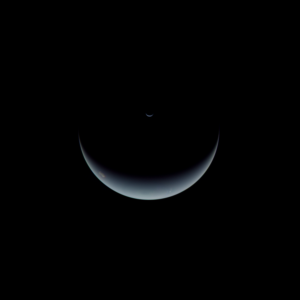
Planets Big and Small
Eve Lee, Ph.D.
Sunday, July 10, 2022
7:30 PM to 9:00 PM EST
Online event
Monthly Meeting – Public Invited
Abstract:
Planets in our solar system can be divided into rocky terrestrials as large as the Earth vs. gassy giants as small as Neptune. Planets outside of our solar system, on the other hand, look nothing like our own, with most of these detected exoplanets falling right in between the size of the Earth and Neptune. How can we understand such differences? I will describe the underlying physics that drives the huge diversity in the observed exoplanetary population and discuss how future missions can help us better understand the formation and evolution of solar and extrasolar planets.
Bio:
Dr. Eve Lee is an Assistant Professor of Physics at McGill University in Montreal, Canada. She received her Hon. BSc in Physics and Astronomy at the University of Toronto, PhD in Astrophysics at UC Berkeley, and spent two years as a Sherman Fairchild Postdoctoral Scholar at Caltech before taking up the faculty position at McGill in 2019. At McGill, Dr. Lee leads a theoretical astrophysics group specializing in the formation of stars and planets. She was recently awarded the 2022 Annie Jump Cannon Award from the AAS.
Learn about the formation of supermassive black holes and what exciting new discoveries await us from the James Webb Telescope. Join NOVAC and one of the leading astrophysists in this field of study, Dr. Jenny Greene, Professor of Astrophysical Sciences at Princeton University.
When: 10/9/22, 7:30pm EDT
Where: Dr. Greene will present virtually. Those interested may meet at George Mason University, Exploratory Hall, Room 3301 (arrive as early at 6:30pm).
For those wishing to join virtually here is the link:
NOVAC General Meeting
Sunday, October 9 · 7:30 – 9:00pm
Google Meet joining info
https://meet.google.com/osh-bcyd-gti
Or dial: (US) +1 484-430-1468 PIN: 486 839 001#
More phone numbers: https://tel.meet/osh-bcyd-gti?pin=1354183604637
Talk Title: The birth of supermassive black holes
Abstract: Supermassive black holes are ubiquitous at the centers of massive galaxies in the universe today, but we have no idea when or how these monsters are first formed. For the first time we have the chance to catch them as babies or adolescents just hundreds of millions of years after the Big Bang, thanks to the remarkable performance of the James Webb Space Telescope. I will discuss prospects for first results in this area in the coming year.
Jenny Greene is a Professor of Astrophysical Sciences at Princeton University, where she has been chasing intermediate-mass black holes for more than a decade. She is also the faculty director of the Prison Teaching Initiative.
See featured article on front page for more detail and link to join.
https://www.novac.com/wp/blog/novac-public-meeting-2-5-23-730pm-est/
See featured article on front page for more detail and link to join.
See featured article on front page for more detail and link to join.
Come out and celebrate National Park Week with NOVAC at the Wolf Trap Performing Arts Center in Vienna, Virginia!
Special Notes: Volunteers may setup as early as 3:00 pm! Solar viewing is an option. If you’d like to bring a solar scope, let Kandi Mitchell, NOVAC Outreach Coordinator know ASAP so we can get Wolf Trap to broadcast a start time before sunset. They’ve agreed to do this if we can make the commitment to start early. The event will be held at 1551 Trap Road and be in the Meadow or in case of rain one of the pavilions.


